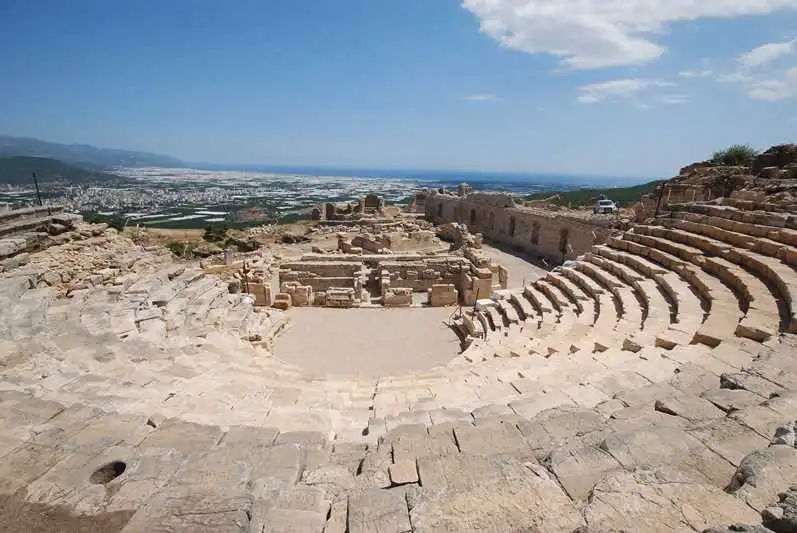Rhodiapolis Ancient City
Description
Rhodiapolis, located on a hill near the village of Sarıcasu in the Kumluca district of Antalya, is considered to be a city founded by the Rhodians because of its name. It is one of the few Rhodian colonies in the region, such as Gagai, Phaselis, Korydalla and Olympos, which are very close to it. According to Theopompos, Rhodiapolis was named after Rhodos, the daughter of Mopsos. The settlement, whose name we learned from Hekataios, developed after it was colonised by the Rhodians. All the cities of the region are members of the Lycian Union. The coins of Rhodiapolis and Gagai are marked "Lycian".
The most famous figure of the city is Opramoas. He lived during the reign of Antonius Pius (138-161 AD) and was the richest man and most famous philanthropist (Euergetes) of Lycia. Opramoas was the son of Apollonius II. His mother Aglais, also known as Aristokila, was from Korydala. He had two brothers, Hermaios and Apollonios III. Opramoas' first position in the Lycian League was archhiphylakia. He was honoured four times after his early service. In the honours between 114 and 131 AD, Opramoas received a bronze statue, a gilded icon and a golden wreath. In 131-132 AD, Opramoas proved his generosity and the Lycian League decided to honour him with annual honours. There was hardly a town in Lycia that Opramoas did not help. Another characteristic of Opramoas is hidden in Hadrian's memoirs. Hadrian says that "the secret reports of the Lydian merchant Opramoas, who knew in detail what was happening in Asia, were ridiculed by Palma". Apart from the rock tomb with a Lycian inscription, Rhodiapolis has no remains from the 7th century BC. The earliest known remains in the city are the rock tombs from the Classical period. Apart from the rock tomb with a Lycian inscription and the Hellenistic tower to the north of the theatre, it gives the impression of a Roman city holding on to its traditions. However, it is the Byzantine buildings, most of which have been destroyed, that dominate the ruins.
The most important remains are the theatre, baths, agora/stoa, sebasteion, temples, church, cisterns, kenotaph, necropolises and residences. The most striking feature of the city is the large number of buildings still standing, built of small stones with or without mortar. They vary in size and many are private houses. In the centre of the town there is a small Greek-style theatre. The cavea of the south-facing theatre, which is thought to have a capacity of about 1500 people, is mostly leaning against the slope and there are 6 cuneus/kerkides between 7 stairs in the cavea. The diameter of the fully circular orchestra is 10.52 meters. The upper part of the stage building, which runs along an east-west axis, has been completely demolished, leaving only the ground floor. Five doors open from the proscenium façade. Behind the stage building, to the south-west of the theatre, is the tomb of the monument, whose walls are completely covered with inscriptions and which contains 64 documents listing all the official relations of Opramoas. In the centre of the city, the Agora and the Stoa form a unit, with the Stoa forming the covered part of the Agora to the west. On the upper part of the theatre there is a church of which only the apse has survived to the west. The last public building on the eastern edge of the settlement is a Roman bath. The general layout of the bath is characteristic of Anatolian baths and gymnasia. The necropolis of Rhodiapolis is concentrated in the east, south-east and north of the city.The most interesting remains of the necropolis, which are mostly Roman sarcophagi, is a rock tomb with an inscription in the Lycian language.
Short Description
Rhodiapolis, located on a hill near the village of Sarıcasu in the Kumluca district of Antalya, is considered to be a city founded by the Rhodians because of its name. It is one of the few Rhodian colonies in the region, such as Gagai, Phaselis, Korydalla and Olympos, which are very close to it. According to Theopompos, Rhodiapolis was named after Rhodos, the daughter of Mopsos. The settlement, whose name we learned from Hekataios, developed after it was colonised by the Rhodians. All the cities of the region are members of the Lycian Union. The coins of Rhodiapolis and Gagai are marked "Lycian".



